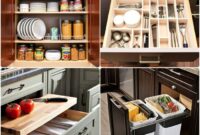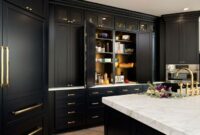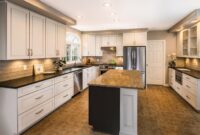Cabinet door designs are more than just functional; they’re a key element in defining the style and personality of a room. From the classic elegance of shaker-style doors to the sleek modernity of slab fronts, the choices are vast and the impact significant. This exploration delves into the world of cabinet doors, covering styles, materials, hardware, sizing, and the latest design trends, equipping you with the knowledge to make informed decisions for your next project.
We’ll examine the properties of various materials, from the enduring appeal of solid wood to the cost-effectiveness of MDF and laminate. We’ll also explore the subtle yet impactful differences between various finishes and wood grains, and how hardware choices can elevate a design. Understanding proportions and sizes is crucial, and we’ll cover that too, along with the influence of current design trends and the role of emerging technologies in cabinet door creation.
Cabinet Door Styles
Choosing the right cabinet door style can dramatically impact the overall look and feel of your kitchen or bathroom. The style you select should complement your existing décor and reflect your personal taste. This section explores various cabinet door styles, their characteristics, and suitable applications.
Five Distinct Cabinet Door Styles
The following table details five distinct cabinet door styles, highlighting their visual characteristics and typical materials. Consider these factors when selecting doors for your project. The choice will affect not only the aesthetics but also the overall durability and maintenance requirements.
| Style Name | Material | Visual Characteristics | Suitable Room Types |
|---|---|---|---|
| Shaker | Wood (maple, cherry, oak), MDF | Simple, flat center panel framed by a raised edge; clean lines; minimalist aesthetic. | Kitchens, bathrooms, laundry rooms; versatile and adaptable to various styles. |
| Slab | Wood veneer, MDF, thermofoil | Completely flat; modern and sleek; absence of any raised or recessed panels. | Modern kitchens, contemporary bathrooms; ideal for a minimalist or industrial design. |
| Raised Panel | Wood (oak, cherry, walnut), MDF | Center panel raised from the frame; creates a classic, traditional look; various panel profiles available. | Traditional kitchens, formal dining rooms, butler’s pantries; adds elegance and sophistication. |
| Beaded Inset | Wood (pine, alder), MDF | Center panel sits slightly recessed within the frame; beaded detailing on the frame adds visual interest. | Cottage-style kitchens, farmhouse bathrooms; creates a rustic or charming atmosphere. |
| Glass-front | Wood (various), glass (clear, frosted, textured) | Combines wood frame with glass panels; allows for display of items within the cabinet; various frame styles available. | Kitchens (for displaying dishes or glassware), bathrooms (for storing toiletries), dining rooms (for showcasing china). |
Shaker, Slab, and Raised Panel Cabinet Door Styles: A Comparison
Understanding the pros and cons of shaker, slab, and raised panel styles is crucial for making an informed decision. Each style offers a unique blend of aesthetic appeal and practical functionality.
The following lists highlight the advantages and disadvantages of each style:
- Shaker:
- Pros: Clean lines, timeless appeal, versatile, relatively easy to clean.
- Cons: Can appear plain without intricate hardware, less ornate than other styles.
- Slab:
- Pros: Sleek and modern, easy to clean, minimalist aesthetic.
- Cons: Can show fingerprints easily, less forgiving of imperfections, may not suit all design styles.
- Raised Panel:
- Pros: Classic and elegant, adds visual interest, durable, hides imperfections well.
- Cons: More complex to manufacture, can be more difficult to clean in recessed areas, may not suit modern styles.
Impact of Wood Grains and Finishes on Cabinet Door Aesthetics
The choice of wood grain and finish significantly influences the overall look of your cabinet doors. Different wood types offer unique visual textures and colors, while finishes can enhance or alter the perceived style.For example, a cherry wood cabinet door with a natural finish will project a warm, traditional feel, whereas the same door with a high-gloss white finish will appear modern and sleek.
Similarly, a rustic oak cabinet door with a distressed finish will evoke a farmhouse aesthetic, while a smooth maple door with a clear lacquer finish will present a clean, contemporary look. The interplay between wood grain and finish allows for immense customization and stylistic flexibility.
Cabinet Door Materials: Cabinet Door Designs
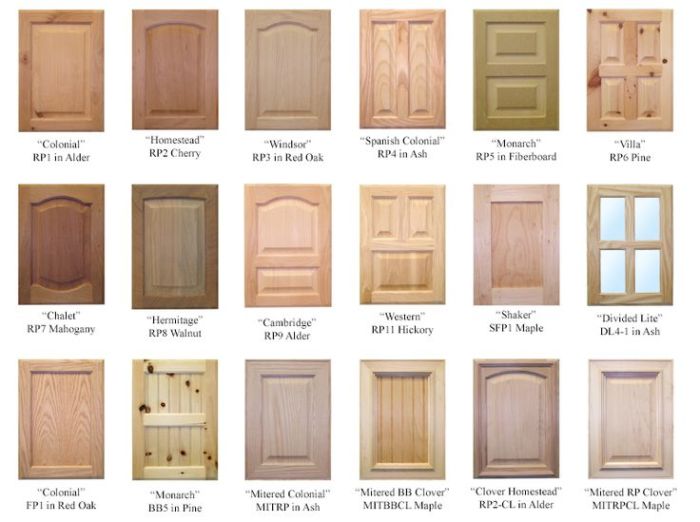
Source: fidelitybuildersanddesign.com
Choosing the right material for your cabinet doors significantly impacts their look, durability, and overall cost. The material you select will influence everything from the aesthetic appeal to how much maintenance they require over time. This section will explore the properties of several common cabinet door materials to help you make an informed decision.
Cabinet door designs are key to kitchen aesthetics; the right style can completely transform a space. If you’re looking for truly unique options, consider exploring the possibilities of bespoke cabinetry. Check out Bespoke Cabinetry Services to see how custom designs can elevate your cabinet door choices, allowing for personalized details and finishes to perfectly match your vision.
Ultimately, the perfect cabinet door design starts with a collaborative approach.
Cabinet Door Material Properties
The following table summarizes the key properties of common cabinet door materials:
| Material | Durability | Cost | Maintenance |
|---|---|---|---|
| Solid Wood | High; resistant to damage but susceptible to scratches and dents depending on the wood type. | High | Requires regular cleaning and occasional refinishing; susceptible to warping if not properly sealed. |
| MDF (Medium-Density Fiberboard) | Medium; prone to chipping and scratches if not properly finished. | Medium | Requires careful handling; susceptible to water damage; needs regular cleaning. |
| Laminate | Medium; resistant to scratches and moisture but can chip if impacted. | Low | Easy to clean; resistant to stains. |
| Glass | Medium-High; resistant to scratches and stains but can break if impacted. | Medium | Easy to clean; prone to fingerprints. |
| Metal (Aluminum, Steel) | High; durable and resistant to damage but can dent. | Medium-High | Relatively low maintenance; wipe clean with a damp cloth. |
Solid Wood vs. Engineered Wood
Solid wood offers a classic, luxurious look and feel, exhibiting unique grain patterns and natural variations. However, it’s more expensive and requires more maintenance. It’s also susceptible to warping, cracking, and expansion/contraction with changes in humidity. For example, a cherry wood cabinet door will age beautifully, developing a rich patina over time, but it will need periodic refinishing to maintain its luster.Engineered wood, such as MDF or plywood, provides a more consistent surface and is less prone to warping.
It’s generally more affordable and easier to work with, making it a popular choice for mass-produced cabinets. However, it may lack the character and warmth of solid wood. A common example is MDF cabinets often used in contemporary kitchens, offering a smooth, easily paintable surface at a lower price point compared to solid wood. They may be less durable in terms of withstanding impacts, however.
Cabinet Door Design Examples, Cabinet door designs
Here are three cabinet door designs utilizing different material combinations:
1. Design 1
Shaker-style door with a solid oak frame and glass panels. The oak frame provides strength and durability, while the glass panels allow light to penetrate the cabinetry, creating a brighter kitchen. The shaker style is chosen for its timeless appeal and clean lines.
Cabinet door designs can really make or break the look of your storage. From sleek and modern to rustic and charming, the options are endless. If you’re looking for high-quality storage solutions for your garage, check out the Premium Garage Storage Cabinets to see how their cabinet door styles can complement your space. Ultimately, choosing the right cabinet doors is key to a well-organized and aesthetically pleasing garage.
2. Design 2
Modern slab door with a high-gloss white laminate finish on MDF. This design offers a sleek, minimalist aesthetic. The laminate finish is highly durable and easy to clean, making it ideal for high-traffic areas. The MDF core provides a cost-effective alternative to solid wood, maintaining stability and a flat surface.
3. Design 3
Cabinet door designs are a key element in kitchen aesthetics, impacting everything from the overall feel to the functionality. Choosing the right style can dramatically enhance your space, and for truly exceptional results, consider the expertise offered by High-End Cabinetry Solutions to elevate your cabinet door designs to the next level. Their custom options ensure a perfect match for your vision.
Rustic-style door with a distressed pine wood frame and metal accents. The distressed pine provides a charming, aged look. Metal accents, such as brushed nickel handles and hinges, add a touch of industrial style and enhance durability in high-use areas. The combination of materials creates a visually interesting and functional design.
Cabinet door designs are a key element in kitchen aesthetics, influencing the overall look and feel. Choosing the right style often depends on the type of cabinetry you’re working with; for example, if you’re considering a flexible and customizable system, check out the options available with Modular cabinets. Ultimately, your cabinet door designs should complement your chosen system and personal style for a cohesive and stylish space.
Cabinet Door Hardware
Choosing the right hardware can significantly elevate the aesthetic appeal and functionality of your cabinets. The style, material, and finish of knobs, pulls, and hinges all contribute to the overall look and feel of your kitchen or bathroom. Careful consideration of ergonomics is also crucial for ease of use and long-term satisfaction.
Cabinet Knob and Pull Styles
Five distinct cabinet knob and pull styles offer diverse aesthetic impacts and ergonomic considerations. Material and finish options further expand the design possibilities.
- Cup Pulls: These recessed pulls offer a sleek, minimalist look, ideal for modern or contemporary kitchens. Their recessed design minimizes protrusion, preventing accidental bumps and maximizing space efficiency. Materials range from brushed nickel and stainless steel for a modern feel to polished brass or antique bronze for a more traditional aesthetic. Finishes can be matte, satin, or high-gloss.
- Bar Pulls: Offering a clean, linear look, bar pulls are exceptionally ergonomic, providing ample grip space for easy opening. They suit various styles, from transitional to modern. Materials commonly include stainless steel, aluminum, and zinc alloys, with finishes such as brushed nickel, oil-rubbed bronze, and polished chrome.
- Knobs: Classic and versatile, knobs are available in countless styles, from simple spherical designs to ornate, detailed pieces. Their size and shape influence ergonomics; larger knobs are generally easier to grip. Materials vary widely, including ceramic, glass, wood, and metal, with a broad spectrum of finishes. Consider the weight and feel when choosing a knob.
- Apron Pulls: These pulls feature a long, flat design with a raised or textured surface, offering a comfortable grip and a rustic or farmhouse aesthetic. Materials like wrought iron, cast iron, and even wood are popular choices. Finishes often include black, distressed bronze, or antique brass to enhance the vintage feel.
- Edge Pulls: These minimalist pulls are mounted directly on the cabinet edge, providing a clean, uncluttered look. They are particularly suited to sleek, modern designs. Materials typically include stainless steel or aluminum, with finishes such as brushed nickel or polished chrome. Their slim profile requires a precise grip.
Cabinet Hinge Types
The choice of cabinet hinges significantly impacts both the functionality and aesthetic of your cabinets. Overlay, inset, and full overlay hinges each offer unique advantages and disadvantages.The selection of hinges depends on the desired cabinet door style and the overall aesthetic of the kitchen or bathroom.
- Overlay Hinges: These hinges allow the cabinet door to overlap the cabinet frame.
- Pros: Easy installation, readily available, cost-effective, hides the cabinet frame.
- Cons: Can look less refined than inset hinges, may not offer full access to the cabinet interior.
- Inset Hinges: Inset hinges allow the cabinet door to sit flush with the cabinet frame.
- Pros: Clean, sophisticated look, provides full access to the cabinet interior.
- Cons: More complex installation, requires precise measurements and adjustments, more expensive.
- Full Overlay Hinges: These hinges allow the cabinet door to completely cover the cabinet frame.
- Pros: Modern and sleek appearance, maximizes cabinet face visibility.
- Cons: Requires precise cabinet construction, may require specialized hinges, less forgiving of errors during installation.
Unique Cabinet Door Hardware Design
This design incorporates a combination of antique brass cup pulls and modern, brushed nickel bar pulls on a shaker-style cabinet door made from light oak. The contrast between the vintage cup pulls on the upper cabinets and the sleek bar pulls on the lower cabinets creates visual interest and balances the traditional and contemporary elements. The warm tones of the antique brass complement the light oak, while the brushed nickel provides a subtle modern touch.
The combination creates a unique and cohesive design.
Cabinet Door Sizes and Proportions
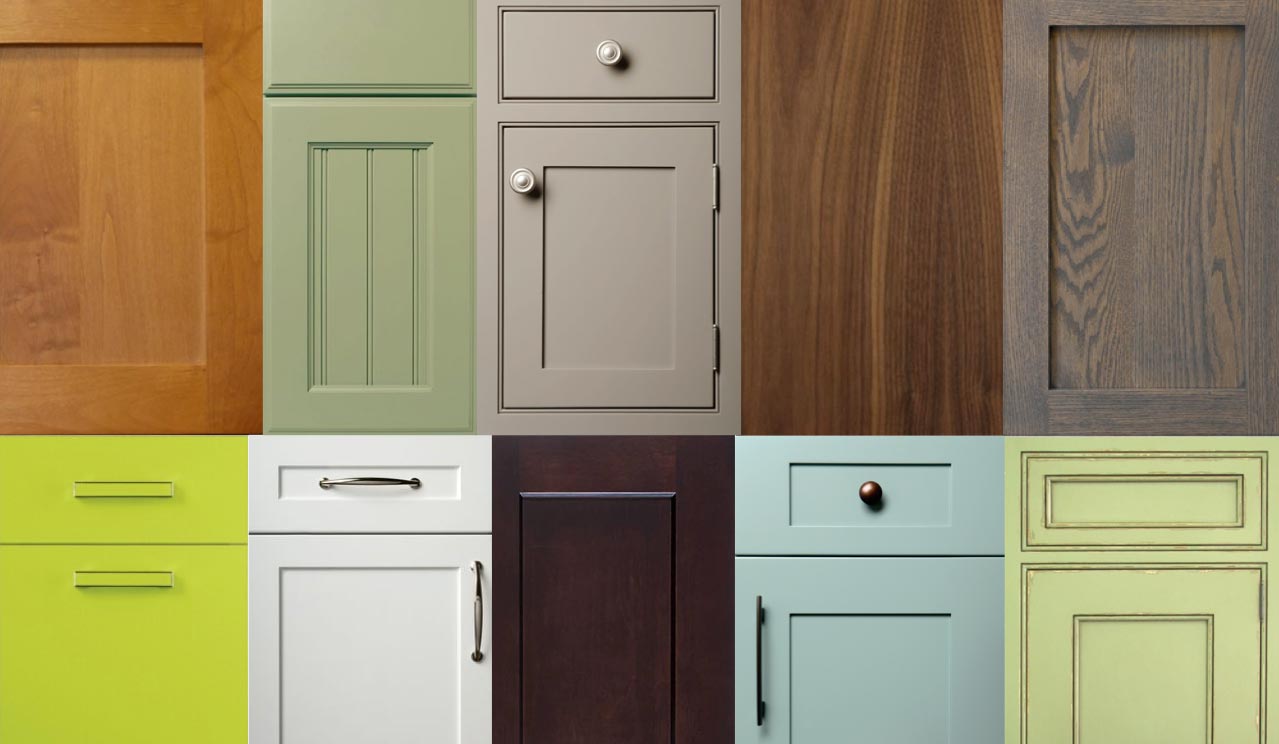
Source: squarespace.com
Choosing the right size and proportion for your cabinet doors is crucial for a well-designed kitchen. It’s about more than just functionality; the visual impact of properly sized doors significantly affects the overall aesthetic appeal of the space. Poorly proportioned doors can make even the most beautiful cabinets look awkward and unbalanced, detracting from the room’s design.Cabinet door sizes and proportions directly influence the perceived scale and balance of your kitchen.
Overly large doors can overwhelm a smaller space, making it feel cramped, while excessively small doors can make a large kitchen feel disjointed and visually fragmented. The golden ratio, although not strictly adhered to in cabinet design, serves as a useful guideline for achieving pleasing proportions. The relationship between the height and width of the doors should be carefully considered in relation to the overall cabinet size and the surrounding elements.
Calculating Appropriate Cabinet Door Sizes
Accurately calculating cabinet door sizes ensures a seamless fit and a professional finish. The process involves several steps:
1. Measure the cabinet
Carefully measure the height and width of the cabinet opening, taking into account any existing frames or moldings. Record these measurements precisely.
Cabinet door designs are incredibly varied, offering everything from sleek modern styles to ornate traditional looks. If you’re aiming for a relaxed, breezy feel, you might consider the lighter, brighter aesthetic of Coastal cabinets , which often feature glass or lighter wood tones. Ultimately, the best cabinet door design depends on your personal style and the overall look you want to achieve in your kitchen or bathroom.
2. Account for overlaps and gaps
Cabinet doors typically overlap slightly, and small gaps are often left for ease of movement. Consider a standard overlap of ⅛ inch to ¼ inch per door and a gap of 1/16 inch to ⅛ inch between adjacent doors.
3. Determine the number of doors
Decide if you need one or two doors per cabinet. A single door is suitable for smaller cabinets, while larger cabinets often require two doors for easy access.
4. Calculate individual door dimensions
If using two doors, divide the total cabinet width (after accounting for overlaps and gaps) by two. This gives you the width of each door. The height of each door will generally be the same as the cabinet’s height (minus any overlaps or gaps at the top and bottom).
5. Double-check and adjust
Before finalizing your measurements, review your calculations and make any necessary adjustments to ensure a precise fit. A slight discrepancy can lead to installation problems.
Cabinet Door Sizing and Placement in Different Kitchen Layouts
The optimal sizing and placement of cabinet doors vary depending on the kitchen layout.
Galley Kitchen: In a galley kitchen, where cabinets are arranged along two parallel walls, maintaining consistent door sizes across matching cabinets creates a sense of unity and visual flow. For example, a galley kitchen with 30-inch base cabinets might utilize two 14.5-inch doors per cabinet, with a 1/16-inch gap between them. Upper cabinets, typically 36 inches tall, could use a single door per cabinet, approximately 36 inches tall and 15 inches wide.
L-Shaped Kitchen: L-shaped kitchens often feature a corner cabinet, requiring careful consideration of door sizes and hinges. The corner cabinet might use doors that swing out from one side or a specialized corner cabinet system. For other cabinets, maintaining consistent door sizes across similar cabinets is recommended. For example, standard 30-inch base cabinets might use the same door sizes as in a galley kitchen.
U-Shaped Kitchen: U-shaped kitchens offer more flexibility in cabinet placement and door sizes. However, maintaining consistency within each cabinet type helps to maintain visual harmony. Consider using larger doors on taller cabinets and smaller doors on shorter cabinets, while maintaining a consistent style and material throughout.
Modern Cabinet Door Trends
Cabinet door design is constantly evolving, reflecting broader shifts in interior design aesthetics and technological advancements. Understanding current trends is crucial for homeowners and designers alike, ensuring kitchens and bathrooms remain stylish and functional. This section will explore three key trends shaping modern cabinet door design, examining their stylistic influences and the technological innovations driving their production.
Three Current Trends in Cabinet Door Design
Three significant trends currently define modern cabinet door styles: the enduring appeal of sleek, handleless designs; the rise of textured and patterned doors; and the increasing integration of sustainable materials.
| Trend | Description | Examples |
|---|---|---|
| Handleless Cabinet Doors | Characterized by a clean, minimalist aesthetic, handleless doors utilize push-to-open mechanisms or integrated grooves for opening. This creates a seamless, uncluttered look, enhancing the modern feel of a kitchen or bathroom. | Imagine a sleek, white kitchen with high-gloss, handleless cabinets. The doors are perfectly flush, creating a smooth, unbroken surface. Another example would be a darker, matte-finish handleless cabinet in a contemporary bathroom, where the push-to-open mechanism is almost invisible. |
| Textured and Patterned Cabinet Doors | Moving beyond plain surfaces, this trend embraces tactile and visually interesting cabinet doors. Materials with inherent texture, like wood veneers with pronounced grain, or doors with embossed patterns or inlaid designs, add depth and visual interest. | Consider a kitchen featuring cabinets with a deeply grained walnut veneer, showcasing the natural beauty and texture of the wood. Alternatively, imagine cabinets with a subtly embossed geometric pattern, adding a sophisticated touch without being overly ornate. Another option would be a bathroom with cabinets featuring a unique inlaid design, perhaps using contrasting materials like mother-of-pearl or metallic accents. |
| Sustainable and Eco-Friendly Materials | Driven by growing environmental awareness, this trend prioritizes the use of sustainable and recycled materials in cabinet door production. This includes reclaimed wood, bamboo, recycled plastic, and sustainably sourced veneers. | A kitchen might feature cabinets made from reclaimed barn wood, showcasing unique textures and character. Another example could be cabinets constructed from rapidly renewable bamboo, offering a sustainable and visually appealing alternative to traditional hardwoods. A bathroom might utilize cabinets made from recycled plastic, offering a durable and environmentally responsible option. |
Minimalist and Maximalist Influences on Cabinet Door Styles
Minimalist design emphasizes simplicity, clean lines, and functionality. In cabinet doors, this translates to sleek, handleless designs, often in neutral colors and simple geometric shapes. Maximalist design, conversely, embraces richness, detail, and ornamentation. This can be seen in cabinet doors with intricate carvings, bold colors, and textured surfaces.
A minimalist kitchen might feature flat-panel, handleless cabinets in a neutral shade like white or light gray. In contrast, a maximalist kitchen might boast ornate, hand-carved cabinet doors with rich, dark wood finishes and elaborate hardware.
Technological Impacts on Cabinet Door Design and Production
D printing and CNC machining are revolutionizing cabinet door production. 3D printing allows for the creation of highly customized and complex designs, while CNC machining offers precision and efficiency in mass production.
3D printing enables the creation of intricate, bespoke cabinet doors with unique shapes and patterns, previously impossible with traditional methods. CNC machining, on the other hand, allows for the precise and rapid production of doors with complex designs, ensuring consistency and high quality in large-scale projects. However, 3D printing currently faces limitations in terms of material choice and production speed for large-scale projects, while CNC machining requires significant upfront investment in equipment.
End of Discussion
Ultimately, the perfect cabinet door design hinges on a thoughtful blend of aesthetics and practicality. By considering the style, material, hardware, and overall proportions, you can transform a simple cabinet into a stunning focal point. Whether you embrace minimalist simplicity or maximalist opulence, the journey of selecting the right cabinet doors is a rewarding one, allowing you to personalize your space and express your unique design sensibilities.
User Queries
What’s the difference between overlay and inset hinges?
Overlay hinges allow the door to cover the cabinet frame, while inset hinges leave a gap between the door and frame, creating a more traditional look.
How do I clean different cabinet door materials?
Wood doors generally require gentle cleaning with a damp cloth; laminate and MDF can handle slightly more aggressive cleaning; glass should be cleaned with glass cleaner.
What are some budget-friendly cabinet door options?
MDF with a laminate finish or melamine doors are generally more affordable than solid wood options.
How important is proper cabinet door alignment?
Proper alignment is crucial for both aesthetics and functionality; misaligned doors can look sloppy and may hinder smooth opening and closing.
Where can I find inspiration for cabinet door designs?
Browse home improvement magazines, websites, and social media platforms like Pinterest and Instagram for a wealth of ideas.

